Tags
baking, Cake, Christmas desserts, Dessert, fairytales, Gingerbread, Grimm's Fairytales, Hansel and Gretel, holiday dessert, The brothers Grimm
In the annals of books that upset and terrified me, Grimm’s Fairy Tales is surprisingly absent. It would make a heck of a lot more sense if this collection of creepy and horribly violent stories had kept me up at night as a kid, but for some reason I simply couldn’t get enough of them. In third grade I discovered a dusty, old copy of the book in my attic while snooping around after school with my best friends, Christie and Meg. We were heavily into mysteries and ghost stories at the time and when we found the book we were certain that we had discovered some dark secret that my parents had tried to keep under lock and key. The book was tremendously old, with gilded pages and illustrations covered by thin sheets of onion paper, full of beautiful words like “dearth” and “soothsayer” and “earthenware,” and it was certainly not yet edited to be “appropriate” for children. From then on, every chance we got, we snuck up to the attic, settled on some old packing blankets and read it by flashlight. (There was, of course, ample lighting up in the attic, but that wouldn’t have felt very authentic).
In reality, my parents had gotten the book as a gift from a distant relative after my older sister was born and stashed it in the attic, thinking (with very good reason) that it wasn’t well suited for bedtime reading. The only real memory I have of this older-than-time relative is being forced to sit on her lap at a family gathering when I was very little and her telling me, “If you don’t brush your hair, your thumbs will fall off!” so it makes a lot of sense that she was the one who gave my parents the book. Grimm’s Fairy Tales are full of violence—people losing limbs or getting lost in forests or being eaten by witches or wolves—and they are full of food.
Jacob and Wilheim Grimm knew well what it was like to want for food. Although they lived comfortably for the first few years of their life, by the time they reached their teens they had been orphaned and left to care for their younger siblings. While writing their collection of fairy tales they were often eating only one tiny meal a day in order to make sure that their brothers and sisters were properly fed, so it makes sense that food would figure so powerfully into almost all of their stories. It is either overly abundant or absent completely, it heals and destroys, taunts, teases, nourishes and saves, but it is always there.
After reading a few tales, Christie, Meg and I always found ourselves terribly hungry, and often, while eating graham crackers and peanut butter and ice cold milk, we felt vaguely guilty thinking of the starving characters we had just read about. It was conveniently close to Christmas when we reached the story of Hansel and Gretel. We had ferreted a few Christmas decorations up to the attic that we thought our parents wouldn’t miss and switched from reading by flashlight to reading by electric advent candle. All three of us had read an edited, child-friendly version of the story at some point in our lives, which made the discovery of the original version all the more shocking. We were disgusted by Hansel and Gretel’s father, so willing to kill his own children at his horrible new wife’s bidding, and incensed that he got away scot-free in the end. The scene that shocked me the most, though, was the one where Hansel and Gretel discover the witch’s house and immediately begin to devour it with abandon, not even pausing when the old woman appears and yells that someone is eating her house! I was raised to be terrified of adults, petrified of ever disrespecting an old person, and I was horrified at Hansel and Gretel for being so piggish and rude to the old lady, witch or not.
I decided that the only way to rectify this huge misdeed was to build our own version of the witch’s destroyed house, and Christie, Meg and I began drawing enormous, intricate blueprints for the ultimate gingerbread house. Meg’s had spiral staircases and balconies with frosting icicles hanging from them, Christie’s had colorful stained glass sugar windows and mine had pink spun sugar clouds suspended above it and a pistachio pudding swamp in the back. We learned quickly, when we actually went to build our houses, that we were going to have to pare things down…a lot. We drew and cut and traced, both on paper and on dough, editing and re-working our original ideas, chatting about the fairy tales as we mixed and rolled and waited for things to cool. It was not unlike many professional kitchen experiences I would have years later, bouncing ideas off of fellow cooks, drawing and measuring, dreaming huge and then simplifying, simplifying, simplifying. Hours later, eyes bleary and fingers cramped we stood back to look proudly upon our crooked masterpiece, and even though our stomachs were grumbling and our noses were full of the smell of molasses and cloves, we didn’t eat an inch of it, not one broken corner.
I have always found it frustrating that gingerbread houses—which are glorious in their complete edibleness—are not meant, really, for eating. You toil and sweat, smelling good smells and touching sticky dough and mixings sweet icing for hours and your only reward is visual—it seems terribly wrong. This gingerbread cake is not only great because it is actually meant for devouring, I love it because it is serious and grown-up and dark, which is how I think the Grimm brothers would have wanted it to be. The tart cranberry syrup pairs perfectly with the cake’s heavy spicing, and it looks creepy to boot.
Gingerbread Cake with Cranberry Syrup
Ingredients:
- 2 cups AP flour
- ¼ teaspoon kosher salt
- 1 ½ teaspoons baking powder
- 2 tablespoons ground ginger
- 1 teaspoon ground cinnamon
- ¼ teaspoon grated nutmeg
- ¼ teaspoon ground cloves
- 1/8 teaspoon ground cardamom
- 1/4 teaspoon freshly cracked black pepper
- 1/4 teaspoon salt
- ½ teaspoon baking soda
- 1 cup Stout (I use Guinness)
- 1 cup dark molasses (don’t use blackstrap, it’s too bitter)
- 3 large eggs
- 1 cup dark brown sugar, packed
- 1 cup sugar
- 1 teaspoon good vanilla
- ¾ cup butter, melted
Directions:
Sift all of your dry ingredients minus the baking soda (flour, salt, baking powder, spices) together in a large bowl and set them aside. Add molasses and stout together in a heavy-bottomed pan, and bring them up to a boil before removing them from the heat. Whisk baking soda into molasses/stout mixture and set aside. Melt butter and pour it into a mixer fixed with a paddle attachment. Add brown and white sugar to the butter and beat until smooth, adding eggs one at a time and beating until fluffy. Alternate adding dry ingredients and molasses/stout mixture to the butter, just until everything is incorporated. Pour batter into well-grease bundt pan and bake for 40-50 minutes, or until a tester comes out clean. Allow the cake to cool in the pan at least 10 minutes before turning it out onto a cooling rack. It is delicious right out of the oven, but gets better and better over the course of three days.
Cranberry Syrup
Ingredients:
- 1 cup fresh or frozen cranberries, roughly chopped
- 1 cup water
- 1 cup granulated sugar
Directions:
Put sugar and water in a saucepan and dissolve over medium heat. Add chopped cranberries and bring to a boil. Boil for 10-15 minutes, pushing down on the cranberries gently with the back of a spoon. Strain and allow to cool completely. Serve with gingerbread cake and fresh whipped cream.

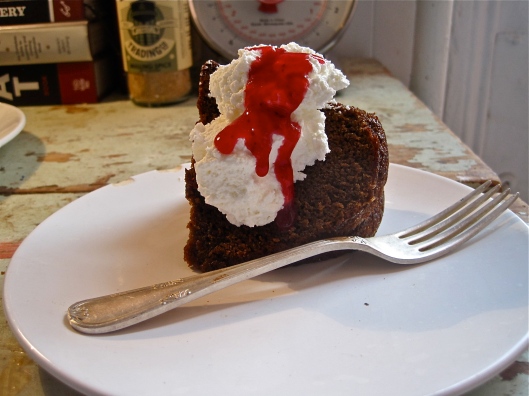
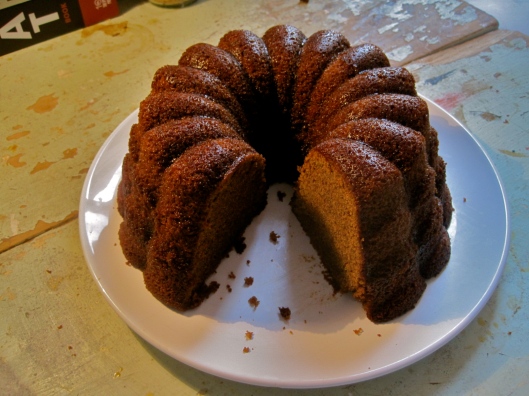
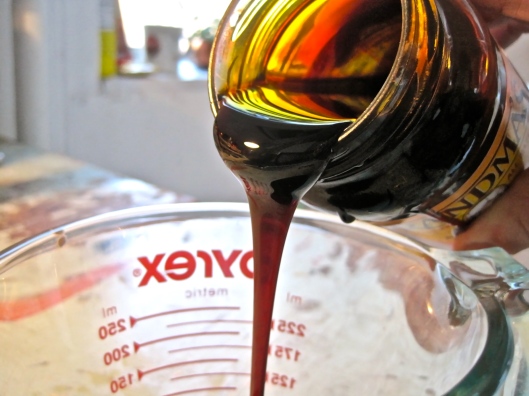
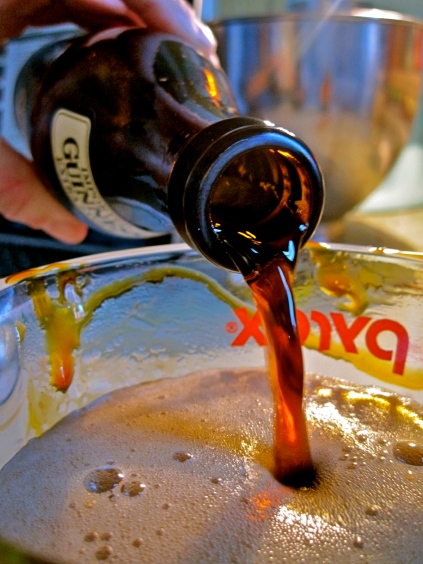
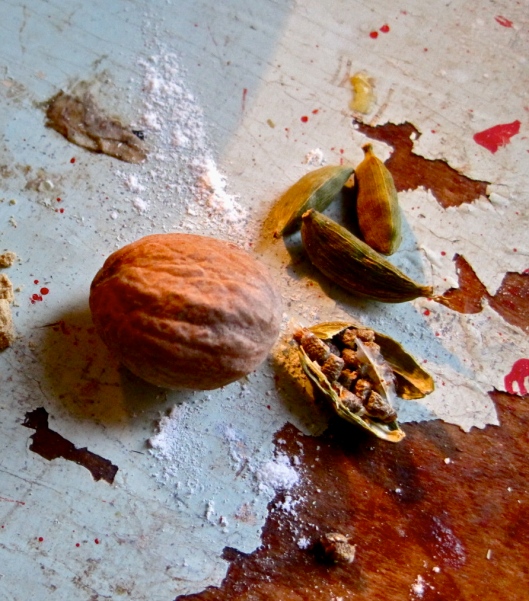
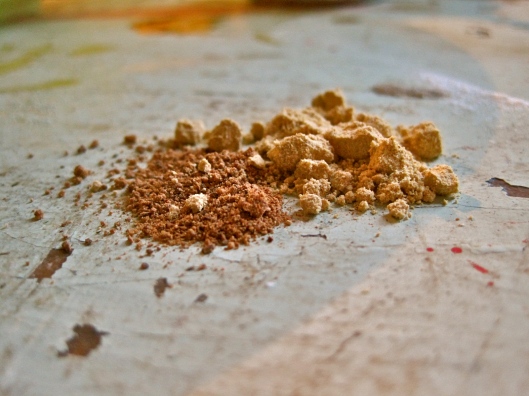
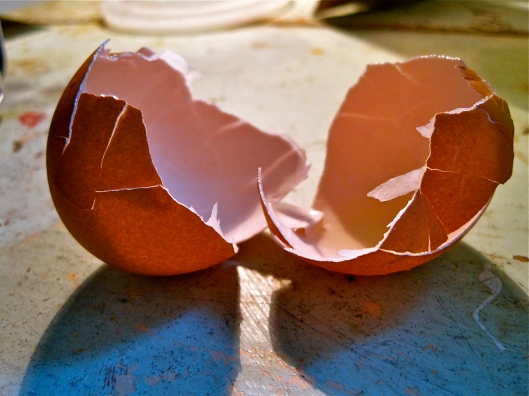
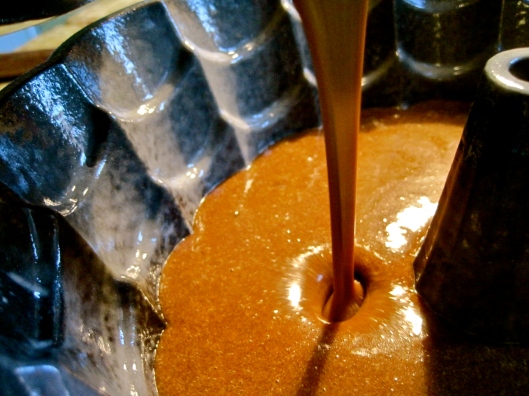
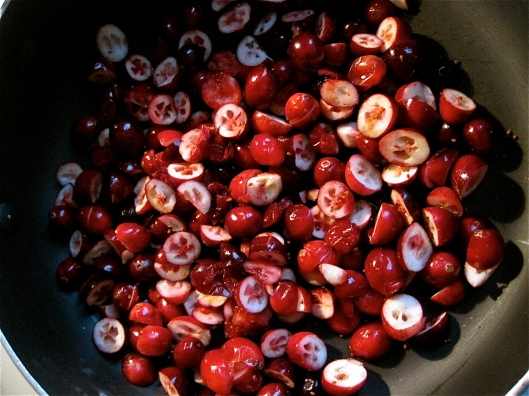
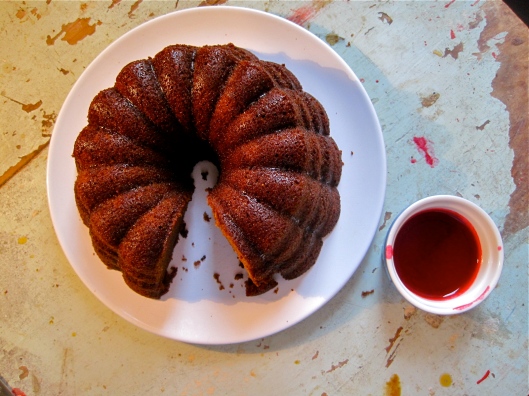
This is such a beautiful dessert! Also, a great new way to max out my gingerbread consumption during the holidays. Going to add this to my Christmas dinner! Keep up the great work.
I think Dawn would love this cake, I want you to make it for her. Also I want you to help me eat the leftovers.
Yummy is the best word I can think of to describe this cake. Perfect timing, too! Stout and molasses will always remind me of Christmas. Love that you went the unexpected route with this recipe. A gingerbread house would have been predictable; this is so unique!
I love your description of hiding in the attic reading Grimms with friends, it sounds so cozy and nostalgic 🙂
It really was–some of my most favorite memories!
Cara, As usual a wonderful story and recipe. It’s especially different in that the “house” is edible.
Keep up the good work,
Seymour
Hello Seymour! I couldn’t bear another year of toiling over an inedible gingerbread house, I enjoyed this so much more. Thank you for always reading and commenting!
Tasty, and perfect for Xmas. Very evocative story too – i always wanted an attic as a kid. That’s weird, isn’t it? Yeah it is.
Not weird at all, Sarah! Attics are magical, cozy places. If i ever own a home I will make sure the attic is properly outfitted to be the ultimate hideaway reading nook.
You, Christie and Meg were a truly great team. Thinking back to the days when the 3 of you were dreaming and scheming brings back sweet memories. Let’s make this cake together!
We really were! Writing this brought back a lot of very happy memories. I can’t wait to make this cake with you!
Cara
This is wonderful. Loved it! Man, can you ever write…
Thank you, Jim!
Give me the Grimms, give me Andersen—the older and more grisly versions the better! And what a fine cake you made.
it’s no hobbit hole covered in fondant leaves but it goes better with my coffee!
Love it! Is there a reason to chop up the cranberries? I don’t think I have ever chopped them up before cooking . . . maybe blitzed them in a blender afterwards . . .
Those Grimm Bros Fairy Tales are way creepy. It’s so strange how they are both not appropriate for children and very appropriate for children. You have read Bruno Bettelheims’s The Uses of Enchantment, yes?
I have had “The Uses of Enchantment sitting in my apartment WAITING to be read since it came out in 2010, but I always, somehow, forget about it. Thank you for reminding me! I am going to crack it open this week. The only reason I chop the cranberries is to help them break down and release their juices faster. I have also noticed that they seem to release more juice when they’re split, rather than just taking on the water/sugar and plumping up. It seems silly to chop something so small, I know, so if you absolutely can’t bear to do it I am SURE your syrup will still be delicious!
It’s really great. He is such a good, clear writer and I like his goals in writing the book: to validate the child’s pov and to find new and better ways to communicate with children.
I will try chopping the cranberries. Am intrigued! Thanks for the tip and for the great recipe!
can i replace the butter with oil to make this vegan?
Hi Annie! You can absolutely use equal parts neutral oil to replace the butter. You will also need to replace the eggs–I would use 3/4 cups unsweetened apple sauce. Traditional Guinness is not vegan, but their “extra stout” is, so look for that before baking, or find another vegan-friendly stout. Happy baking, let me know how it turns out!
I found your website while I was googling “gingerbread houses” and decided to completely change my plans of making one! What a beautifully written and executed blog, I can’t wait to share with all of my fellow teachers!
Grimm’s Fairy Tales scared the hell out of me as a kid! I can’t wait to revisit them as an adult…thank you for another wonderful post
What is better than the combination of bundt cake and gingerbread?! And the cranberry syrup adds that surprise factor that I can always count on YOU for! Great story and recipe as always. What will be next!
What kind of camera do you use? your pictures are beautiful!
-Patrick
Kerry shared your blog with me recently, Cara, and I LOVE it! Literature, excellent writing, photography, and food are four of my favorite things and I look forward to sharing it with my book group. But that will have to wait, because I am off to make this extraordinary cake. Glad that even with the cranberry sauce, you included whipped cream on top!
I’ve always felt vaguely guilty about not liking gingerbread and secretly filed it under better in theory than practice. This is so much better.
We made our first gingerbread house, from a kit, and are *not* going to eat it. But I will bake this cake and we’ll eat it all up. Ginger + cranberry: a great seasonal combination!